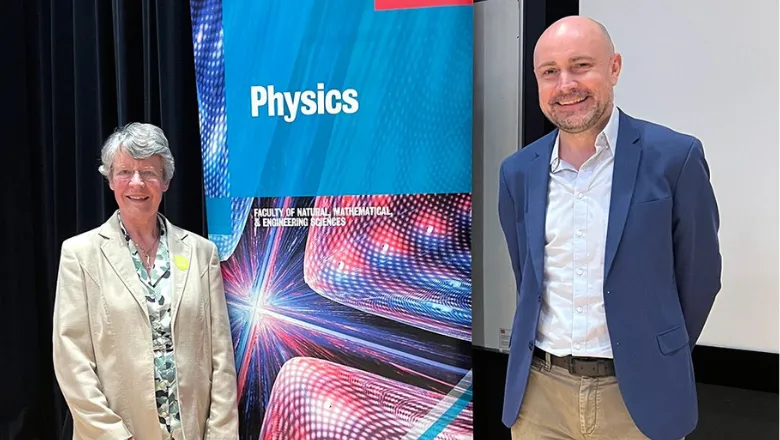One of these bursts contains the same energy as the sun gives over the whole of its lifetime. The energy in the burst is said to be the biggest since The Big Bang created the universe.”
Professor Jocelyn Bell Burnell
25 June 2024
“Transient astronomy is coming of age,” says Professor Jocelyn Bell Burnell at 2024 Higgs Lecture
Astrophysicist Professor Jocelyn Bell Burnell delivered this year's Higgs Lecture at King's College London.

One of the country’s leading astrophysicists, Professor Jocelyn Bell Burnell came to King’s to deliver the 2024 Higgs Lecture earlier this month.
Bell Burnell is most well-known for discovering pulsars – a previously unidentified type of star that emits regular radio waves and electromagnetic radiation. The discovery was made inadvertently when she was a postgraduate student at Cambridge in 1967 and led to the development of a whole new branch of astrophysics. It earned her supervisor Antony Hewish a Nobel Prize in Physics in 1974.
Entitled ‘Bursts, Bangs, and things that go Bump in the Night’, Bell Burnell’s lecture covered the future of transient astronomy – the astronomy that deals with transient objects in space. She explained how the field is growing due to improvements in detector technologies opening the possibilities of more highly variable phenomena to be discovered.
Transients refers to astronomical phenomena that lasts for a relatively short time, from fractions of a second to weeks or years (considered short in space time). Typically, they are extreme events associated with the total or partial destruction of an astrophysical object.
Bell Burnell explained that astrophysicists previously used long exposure telescopes covering tiny fractions of the sky to observe the farthest objects. Scientists can now use multiple, short exposures to observe changes in these distant objects and see how the emitted light changes over time:
“Transient astronomy is coming of age, there’s going to be absolutely deluges of data in the very near future. If the recent past is anything to go by there’s going to be lots of interesting and dramatic results.”
Bell Burnell explained the ‘family’ of light on the Electromagnetic Spectrum, and the telescopes sensitive to different parts of the electromagnetic spectrum used to study optics in space:
“There are of course other radiations like light – there's ultraviolet light, which we can’t see with our eyes. Further along there are X rays, and further along there are gamma rays,”
She went on to discuss the discovery of gamma-ray bursts, immensely energetic explosions of electromagnetic radiation. They were first detected in the late 1960s by Los Alamos scientists while using satellites to monitor whether the Soviet Union was adhering to the Nuclear Test Ban Treaty.
Gamma-rays bursts are now detected at a rate of about one a day and scientists have been working for decades to attempt to understand their origins.
"It quite often happens in astronomy. You think you’ve discovered something, and actually you’ve discovered several things. For a long time, there’s been huge debate about what’s causing gamma-ray bursts,” Bell Burnell said.
“We’ve ended up believing that the long ones are when massive stars explode. The shorter ones are the merger of two very compact stars.”
Bell Burnell gave examples of the type of gamma-ray bursts detected in recent years. In October 2022, an extremely large gamma burst was detected from two billion light years away and dubbed the ‘Brightest of All Time’ (BOAT). She also spoke about long gamma-ray bursts due to the collapse of high mass stars to make neutron stars, quark stars or black holes.
“The energy of these things is quite remarkable. One of these bursts contains the same energy as the sun gives over the whole of its lifetime. The energy in the burst is said to be the biggest since The Big Bang created the universe.”
The Higgs Lecture is delivered by an invited guest speaker each year, since the inaugural lecture in 2012 presented by Professor Peter Higgs who predicted the Higgs Boson particle in 1964. Professor Higgs died in April at the age of 94.
Previous speakers include 2020 Nobel Prize in Physics recipient Sir Roger Penrose; mathematical physicist Sir Michael Berry; and prominent mathematician Professor Caroline Series.

